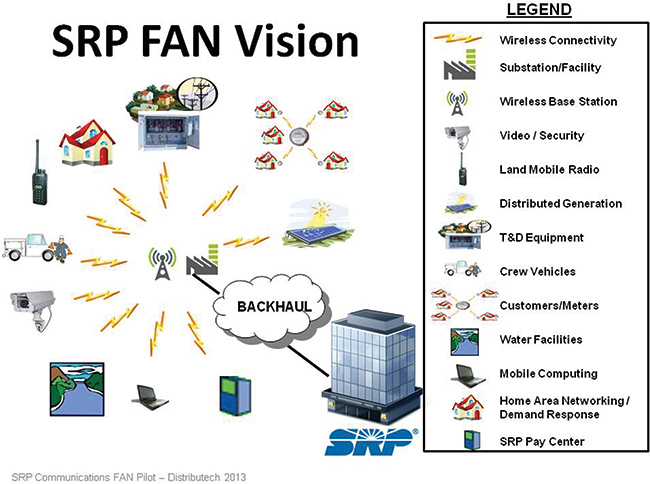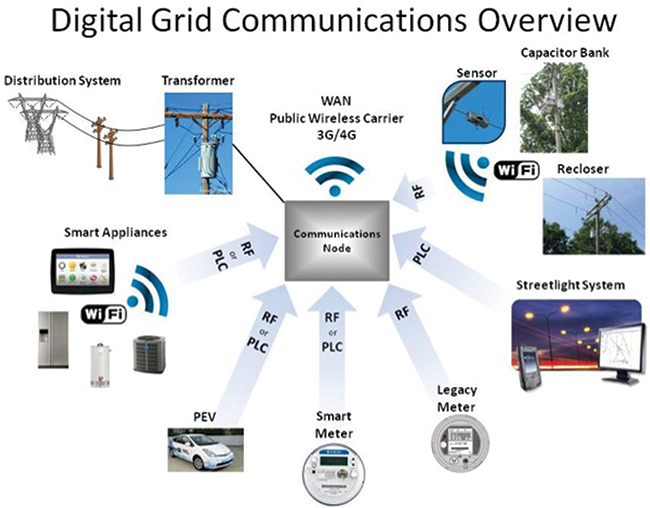Introduction
Customer satisfaction continues to be a key priority for the electric power industry and two key drivers for customer satisfaction are reliability and affordability. Many emerging technologies, sensors, and intelligent devices being deployed on the grid are helping to improve both reliability and affordability, but to successfully enable these technologies a supporting infrastructure must be place. A very important enabler is communication technology that provides the necessary connectivity to not only the devices, but also utility workers.
Over the last six years many large-scale smart grid demonstrations around the world have been applying, evaluating, and demonstrating a wide range of technologies to accelerate the commercialization of electric grid technologies. EPRI’s involvement in these projects along with in numerous other demonstrations around the world has identified communication standards, availability and performance as one of the most significant and common gaps to overcome to achieve the goals of a smarter grid.
To provide just a flavor of emerging applications, their benefit and the associated communication challenges, here are several examples:

Each of these examples can be individually addressed very effectively and in many cases that is exactly what’s happening; however, this is a problem. As each operational or business need is identified, a survey of available communication systems is performed and if there is not an in-place communication infrastructure that will meet the needs, a new one is deployed. As a result, this ‘accidental communication architecture’ is developing. We know communication needs are increasing, communication technology is rapidly evolving, most existing utility infrastructures will not meet future needs, and advanced communication infrastructures can be cost-justified by a single application. With all these factors, it is increasingly important to have a communication technology strategy that takes these factors into account to meet the future electric grid operational needs.
EPRI is addressing these research areas in a number of ways. One project addressing many of these challenges is the Field Area Network (FAN) demonstration. The FAN concept is a ubiquitous, high-performance, secure, reliable network to meet the needs of a broad range of smart grid applications that historically have been performed by separate communication infrastructures. This in turn may produce measurable impacts on the power system. These impacts provide value in the form of reduced utility and customer cost, increased reliability, improved power quality, or reduced impact on the environment. The FAN system itself does not produce these benefits, but can enable all of them. A FAN system with no applications has only a cost, but a FAN system supporting multiple applications can be very valuable.
The following two examples of communication technology strategies from SRP and Duke Energy provide a glimpse into the future of utility communications based on their individual needs and visions.
SRP and their Field Area Network
The SRP power district is one of the nation’s largest public power utilities providing electricity to more than 970,000 retail customers in a 2,900-square-mile service area that spans three Arizona counties, including most of the metropolitan Phoenix area. In addition, SRP delivers about one million acre-feet of water annually to a 375-square-mile service area and manage a 13,000-square-mile watershed that includes an extensive system of reservoirs, wells, canals and irrigation laterals.
SRP is assessing the technical and business options for the deployment of a FAN with an objective to determine the best approach for implementation that offers the capability of unifying existing wireless systems, and to be an enabler for additional Intelligent Electronic Devices to support the electrical distribution network and their water business.
For SRP, the FAN is a strategic capability that provides benefits for existing systems and planned upgrades by unifying a variety of single-purpose communications systems. It provides additional benefits by enabling an additional set of applications that would otherwise be impractical due to technical limitations or cost. The set of applications that SRP evaluated for the FAN include Distribution Feeder Automation, Capacitor Control, Electronic Systems Monitoring, Water SCADA, Water Delivery Gate Keeper, Video, Network, and Advanced Metering is being considered for future evaluation. The project developed the data and analysis to answer the questions: “Should SRP implement a FAN?” and “What type of FAN architecture and technology should be deployed?”
Several approaches to FAN implementation were considered and analyzed as hypotheses:
- Exclusive use of services from one or more public wireless carriers for the Field Area Network
- A private Field Area Network deployed and managed by SRP
- A hybrid combination of public and private Field Area Networks
- A network shared with public safety in the 700 MHz band
These approaches were analyzed based on their fundamental technical characteristics, and estimated costs for deployment and operation. That data, along with the set of application use cases, provided the input to a Cost Benefit Analysis, which provided the economic and business justification for the investment. For SRP, the overall approach being pursued is to develop a private network. This provides the best option from a financial and strategic perspective based on their long term needs.
Duke Energy and their Digital Grid Vision
Duke Energy is the largest electric power holding company in the United States, supplying and delivering energy to approximately 7.2 million customers. It has approximately 57,700 megawatts of electric generating capacity in the Carolinas, the Midwest and Florida – and natural gas distribution services in Ohio and Kentucky.
Duke Energy defines the digital grid as an end-to-end energy Internet powered by two-way digital technology. It is comprised of an Internet Protocol (IP) based, open standards communication network that allows for automation and the exchange of near real-time information as well as enabling the adoption of new technologies as they become available.
This digital grid network must have the bandwidth, embedded sensing, control and software, both distributed and centralized, to collect, organize, and analyze an immense volume of information. This requires the two-way bandwidth to link the real-time events detected with the appropriate grid devices that will respond to those events both grid-wide and locally. This enables utilities to address load and congestion, system stability and equipment health or outages in a more efficient manner and improve reliability.
This network will require an integrated implementation strategy that adheres to a common infrastructure model. An incremental and disconnected approach is more costly and ineffective.
The communications network must make it easier to adopt new technologies and solutions, allowing Duke to take advantage of advancements in storage, micro-grids and distributed generation as well as adapting to future energy transformations. This network will need to support local intelligence that provides autonomous, decision making controls as well as centralized notifications, overrides and inputs with situational awareness from multiple sources. The autonomous operations of the devices will need to take in to consideration factors that include: a customer’s preferences and actions, equipment operating parameters, weather, equipment failures, local and more wide-spread grid activities such as actions in other homes, neighborhoods, cities, and states.
Duke’s communications architecture in Ohio and its smart grid field test area in Charlotte connects public carrier WAN access to each distribution transformer. Simultaneously, the communications node serves as a communications gateway to manage and operate various smart home, smart meter, and distribution devices.
No single technology is capable of meeting the needs of or providing the coverage necessary for the electric utility service territory. A communications node designed to have the options of utilizing wireless and wired connectivity can support three types of communications:
- Wide Area Networking (WAN) –The network connecting the communications nodes to the enterprise data center and back office.
- Local Area Networking (LAN) –The network serving end points such as sensors, capacitor banks, homes, etc. - in the same general area as the communications node. Local connections to communications nodes are considered part of the LAN network (ex: a serial connection to a capacitor bank)
- Node-to-Node Communications (N2N) –A peer-to-peer form of communications that can be utilized in lieu of, or in conjunction with a WAN connection to a communication node.
The communications node architecture can support multiple wireless and wired communications technologies in order to address unique situational requirements. It’s also flexible enough to support very specific applications.
This open hardware/software architecture along with the capability to utilize other manufacturers’ modems as well as end devices (ex: fiber optic equipment, satellite equipment, capacitor banks, reclosers, and sensors) enables flexibility and capability that is needed for our vision of the digital grid.
Conclusion
A cohesive, unified and ubiquitous communication infrastructure is an aggressive goal and many factors play into what solution is the best for each utility. By working together collaboratively, the electric power industry can continue to make significant advances to understand the cost, benefits, challenges and architecture options to prioritize the necessary research that can have the most positive impact on electric grid reliability and affordability.
About the Authors
 Matt Wakefield is Director of Information and Communication Technologies at the Electric Power Research Institute. He has over 25 years of experience in the electric industry and his responsibilities include furthering the development of a modernized grid through application of standards, communication technology, integration, and cyber security.
Matt Wakefield is Director of Information and Communication Technologies at the Electric Power Research Institute. He has over 25 years of experience in the electric industry and his responsibilities include furthering the development of a modernized grid through application of standards, communication technology, integration, and cyber security.
 Joe Nowaczyk is the Director of Electronic Systems at Salt River Project. He has over 29 years of experience in the electric utility business in a variety of positions including Strategic and Resource Planning; Marketing; Metering and Field Services; and Transmission and Substation design and construction. Joe is currently responsible for the engineering, design, construction, and maintenance of SRPs Communication, Protection, and Control Systems.
Joe Nowaczyk is the Director of Electronic Systems at Salt River Project. He has over 29 years of experience in the electric utility business in a variety of positions including Strategic and Resource Planning; Marketing; Metering and Field Services; and Transmission and Substation design and construction. Joe is currently responsible for the engineering, design, construction, and maintenance of SRPs Communication, Protection, and Control Systems.
 Jason Handley, P.E. is Technology Development Manager in the Emerging Technology Office at Duke Energy. Jason has over 18 years of electric utility experience specializing in the smart grid, distribution automation, and operations management. His research and development role allows Jason to use his years of experience to develop, install, test, and evaluate new technologies for Duke’s electrical grid. Jason is responsible for developing and updating the strategic roadmap for power grid devices at Duke Energy.
Jason Handley, P.E. is Technology Development Manager in the Emerging Technology Office at Duke Energy. Jason has over 18 years of electric utility experience specializing in the smart grid, distribution automation, and operations management. His research and development role allows Jason to use his years of experience to develop, install, test, and evaluate new technologies for Duke’s electrical grid. Jason is responsible for developing and updating the strategic roadmap for power grid devices at Duke Energy.









